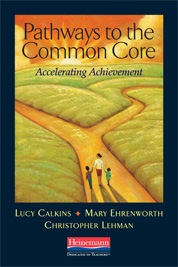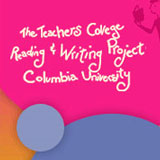Unpacking the Common Core
Pathways to the Common Core: Accelerating Achievement
by Lucy Calkins, Mary Ehrenworth, and Christopher Lehman
(Heinemann, 2012 – Learn more)
We’ve heard for several years that the Common Core is coming, and now that it has arrived, we teachers have a lot of work to do. By now, most teachers have delved into the standards, and many teachers have begun to try to interpret them and decide what the standards really mean for our classrooms. But how do we best begin this Common Core work?
The authors of Pathways to the Common Core: Accelerating Achievement introduce their book by telling us we have a choice in how we approach these new expectations. We can look at the standards in a negative way, or we can embrace what is good in the document. The authors suggest that there is a lot to celebrate within the Core — points they enumerate in detail. This book is written for those educators who are excited to begin to implement the CCSS.
As challenging as it must have been to write and finesse the adoption of the Common Core State Standards, that accomplishment is nothing compared to the work of teaching in ways that bring all students to these ambitious expectations. The goal is clear. The pathway is not.” – Lucy Calkins, Mary Ehrenworth, and Christopher Lehman
In the final section of the introduction, the authors suggest some principles for approaching implementation in districts, schools and classrooms. It’s here that we learn something about their credentials: all three are teacher educators at the Teachers College Reading and Writing Project, which has “helped hundreds of principals and teacher leaders design plans for adopting the Common Core.”
“As we’ve worked together to study school after school,” they write, “a few principles have emerged that are broadly applicable across many different settings” — which they then summarize.
A Deeper Look at the ELA Common Core Standards

Pathways to the Common Core: Accelerating Achievement includes four chapters devoted to the reading standards and four chapters devoted to the writing standards. There is an overview at the beginning of each section with helpful background information. The overview for reading discusses what the standards value and what they don’t value. The overview chapter for writing considers the current state of writing instruction, describes the three types of writing the standards call for, reflects on the quality of writing CCSS expects, and talks about the writing process and the importance of writing across the disciplines. (You can download the table of contents, the introduction and the book’s first two chapters here.)
Inside the Book
The authors have devoted one chapter to reading standards one and ten. A clear metaphor is given for how these standards relate to the others:
“Some people who are close to the Common Core have likened the reading standards to a ladder, with standards 1 and 10 as the crucial struts that form the two sides of the ladder, and the other reading standards as the rungs of the ladder.” (p33)
The next chapter is on reading standards 2-9 for reading literature. The final chapter devoted to the reading standards discusses standards 2-9 for reading informational texts. The 10 anchor standards are the same for reading literature and for reading informational texts. Sometimes the standard is identical at a given grade level, but sometimes there are variations, given the different challenges that reading literature and reading informational texts pose for the student reader.
Following the overview chapter for writing, there are three more chapters about the writing standards, each focusing on a type of writing: argument, informational, and narrative. The authors suggest starting with the narrative writing standard (even though it is third) because many teachers are most familiar with teaching this type of writing. And yes, just as we had anticipated, we are told that argument writing is a big deal in the CCSS.
There is also one chapter dedicated to the speaking, listening, and language standards. This is another overview chapter, so we learn how to best understand these final two strands of the ELA standards in context.
The final chapter addresses assessment. The authors convey information about the two consortia —PARCC and SMARTER Balanced — which have been developing the new Common Core-aligned assessments. Their websites are given, with the suggestion that we go and visit these organizations to learn more. The differences between the two groups’ approaches to testing (at least thus far) are outlined as well.
Plenty of Helpful Information
There is a lot of practical help woven throughout this book. One topic that I found really interesting describes the structure and flow of the standards. The authors continually point out how the standards change as they move up the grade levels. It’s so interesting to see this progression of skills within these new standards. Teachers do not always have the luxury of time to examine where our students have come from, as well as where they are going. If the standards become commonplace in our schools, we will have this information at our fingertips.

They also draw our attention to the sample texts in Appendix C so we can see representative writing that portrays what all eighth grade writers should be able to produce if the Common Core’s ambitious goals are achieved.
I also enjoyed the comparisons the authors made between CCSS, which I don’t know that well, and other topics in education that I do know well. For example, they often reference No Child Left Behind; they mention Fountas and Pinnell’s book leveling system; NAEP; Calkin’s Units of Study for Teaching Writing, and the National Reading Panel Report. For me, these comparisons helped to clarify the connections between CCSS and what has come before.
This book was exactly what I was looking for. I picture myself turning to it time and time again as we continue to implement the Common Core into our school.
Julie DeMicco teaches reading to seventh and eighth graders at Stilwell and Indian Hills junior high schools in West Des Moines, Iowa. She has also taught elementary school and is a former Reading Recovery Teacher. Julie has a passion for helping students find books that they love, as well as being an avid reader herself. She is also one of the anti-bullying club moderators for one of her schools.




































